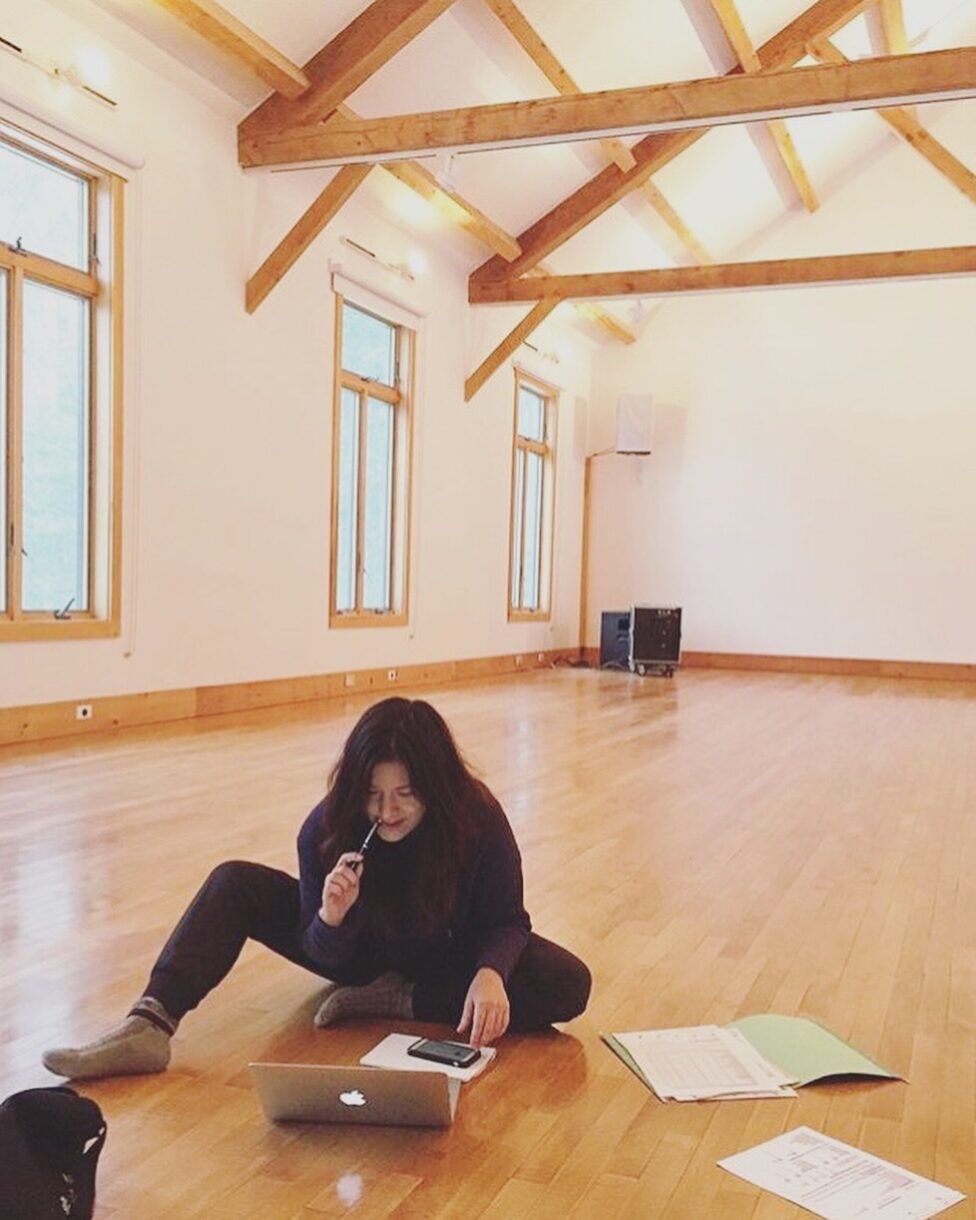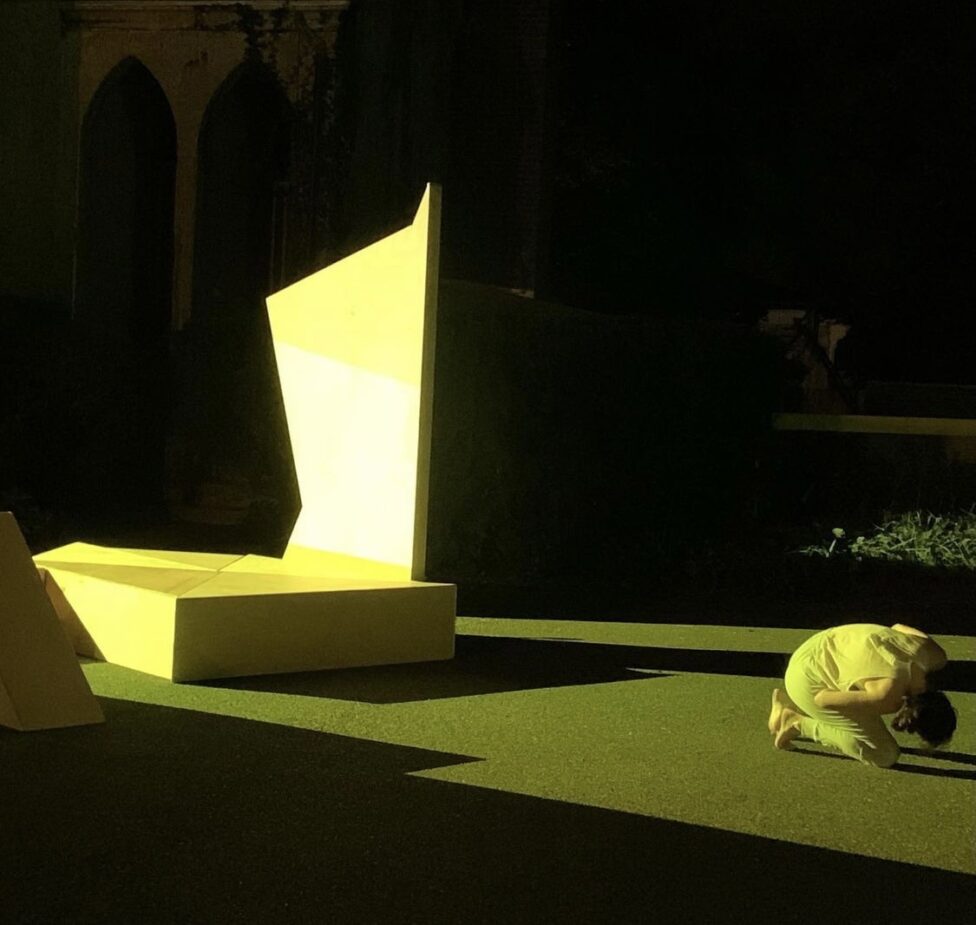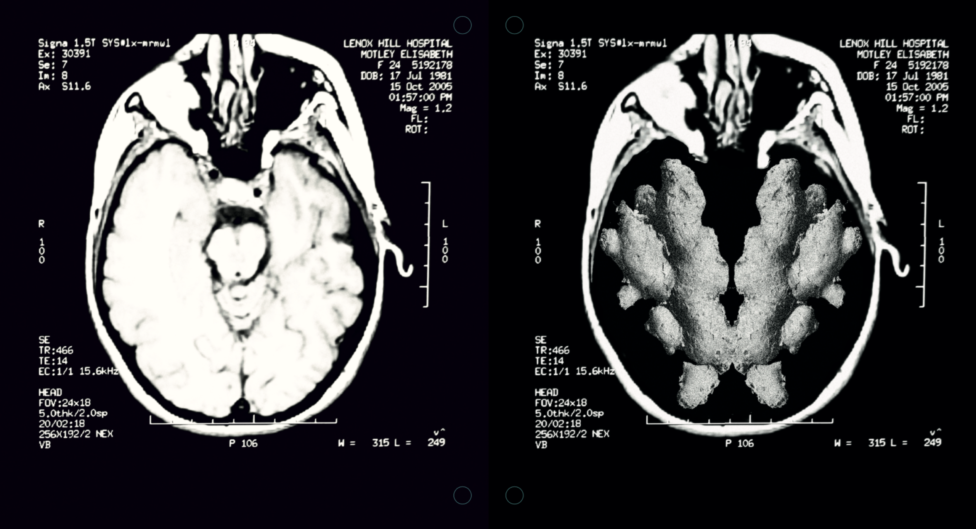Cory Nakasue: I think 2017 is when you told me you were embarking on this project. You asked me to take a look at some choreography you were working on. Then we changed the whole trajectory of that project! [laughter]
Elisabeth Motley: Yeah, you very pointedly told me, “No, you’re not doing what you are saying you wish to do.” And we began again, again, again. It was uncomfortable. You held me accountable to the inquiry.
Prior to this conversation, I was thinking about how this project grew to necessitate multimodal practices, like live-projection and choreographic objects. At the start, we were primarily practicing dance scores dealing with my embodiments of seizure, psychosis, and cognitive and physical disability and taking close reads of my medical archives. We figured out that we needed to also include other modes of performance and presence—like the wooden sculpture objects we worked with and the live projections, which each engage their own improvisational scores—and really figuring out what those procedures were, how they would happen. I’m wondering about how we made decisions together—collaborated to arrive at those conclusions.
CN: This last year of digging into this episode, I felt that I was finally, after a couple of years of working with you, allowing myself to participate in a way where I wasn’t working as I normally do, as an artist or in a dramaturgical capacity. This year, finally, was the year that I opened myself up to, or tried to keep myself open and tried to keep you open to, all the different possibilities of this work. That was such a challenge; dedicating myself to a process of undoing and unmaking to such a profound degree is a real test of the methods I use for valuing and contextualizing movement. It goes beyond movement improvisation and towards an improvisation with time and memory from a multitude of interpretations. The most rigorous part of the process was this unrelenting disruption of interpretation and the effort it takes to allow something to emerge.
EM: We kept saying, we shouldn’t know, there shouldn’t be an answer to the research. Because a cripping, or at least this crip creative practice, intentionally blurs the edges of disability. Crip rustles against the edges of bodily categorization folding in the indecipherably disabled, the unmarked and invisible. An identity as crip resists containment. In terms of the support that you offer in this project as dramaturg, you and I constantly say, “holding open,” and thinking how to not get there, how to not arrive as part of the research and the practice.
CM: Yeah, it was kind of, and I hope this is okay to say: [laughs] I felt like we were practicing a somatic type of edging. Are you familiar with the term “edging” in sexual terms? Yeah, it was like oh, I know this trajectory, I know this path, and in your body and even in your mind you can feel when it’s about to coalesce. I’m almost there. I’m almost there. The cultural and biological urge to complete. For me, anyway, it was so strong. And we were like, no. Instead, once you start to somatically feel like you’re about to coalesce and converge and have something materialize, move it. Or sustain it. Or stay in this super hyper present space of possibility without the concrete materialization. And that is a mind-bender. And also because it was a mind-bender, I also felt it was a body-bender. And I had to really pry open my nervous system to accept that. To feel how strong the pull towards a measurable or a complete expression of a thought or idea actually is. And I know we were really rigorous with that. It was transformative.

Cory Nakasue at Mt. Tremper Arts, 2018, photo by Elisabeth Motley
ID: Cory, an Asian-American Latina, sits on a blond wood studio floor. In a black long-sleeved shirt, black sweatpants, and socks her right leg is crooked out to the side, and her right hand holds a pen, which, probing her lips, is a thinking device. Her long black hair half covers her face as she is looking down at her computer with medical archives spread out beside.
EM: Yes, and this research undercuts the authority of measurement! In particular how bodies are measured, medicalized, and diagnosable. One of the things we’re thinking about is the future, thinking about how to move forward with the research, thinking about how we’re still learning. We still have more to learn from the precarity of the practice and the scores. I’m thinking about how the work that we’re doing is also anti-futuristic, like in alignment with this queer-crip anti-future notion. Crip theorist Robert McRuer talks about how the future cannot be innocent because—before we are even there—the future already carries rhetorics of beauty and order that are normative. How do we imagine a future that those of us at the margins aren’t invited to? So to think about what needs to be in place in order to experiment and explore an anti-futurity is really interesting.
As I started to think about the methodologies and procedures I wanted us to use I began to think about what a rhizomatic proposal of a crip creative practice would be. And all of a sudden I realized I was allowing my practice to serve established hierarchies in the academy and this began to have its limitations. I realized I was trying to fit my embodiments within the constitutions of that theory. (1) And so we really had to flip it and think, no, what does our practice have to offer this theory?
CN: Right. Another way I saw our process was a process of thwarting—which goes against this other idea of constant progress, and moving in a direction of building and concretizing. And there’s another “C” word. Let’s say it’s something like, cataloging. That needs to happen for something to be legitimized. One of the most interesting things in the work that we’ve been doing is this idea of challenging what is legitimate. Or even questioning, very deeply, what legitimacy even means as a way of being or as a way of being true. And, yeah, this is all very conceptual. What does the practice offer to art making?
EM: Not prioritizing the conceptual, instead prioritizing how the dancing is it’s own thinking.
CN: We’ve talked about taking other people through this process and what that would look like. I think it would begin with patterning, expectations, and trajectory or “anti-trajectory” if we’re exploring anti-futurism. What does a pattern feel like for you, intellectually or in your body? And can you catch your patterning? Every living thing on this Earth has some kind of patterning. And, as humans, we can’t change that pattern unless it’s interrupted. And that’s where the process, inherent in your piece and then inherent in our collaboration, of undoing, of thwarting, of dissolution; keeps us really sensitive to the patterns that form very automatically, subconsciously. How do we strengthen the muscles of perceptive interruption to allow for the emergence of a wholly new pattern?
EM: To me what you are also talking about is figuring out where this practice occurs. And understanding what’s around us. How systems of power construct us, and construct disability. So, part of what I think is within the practice that we’re doing (the thwarting of a practice), is then the thwarting and destabilizing and unsettling of where it happens.That because the work engages a radical disability politics, it constantly needs to be decentralized. It can’t be in one place. For it to occur within a traditional theater setting would institutionalize it. When presented by an organization, this project asks that organization to unsettle their authority over the work and allow the project to be in its own territory. Perhaps this is what might make for a radical cultural production? How can this work constantly be reconfigured, improvisational, spontaneous, and create its own landscape? If it doesn’t belong here, now, or in the future, then it needs to imagine place/space differently. In every aspect of this practice, I’m realizing, this is consistently forwarded.
CN: And that would speak to the rhizomatic process, which doesn’t change or create until it meets the pathway of another so that something new can be created. That intersection, that space, or time where they meet is really fertile and in the future, I would like to explore that space more. I think that space—the intersection—is a crip space, a queer space, an erotic space, a liminal space. And that’s where the juice is. To steward it, observe it, and understand it as ever-changing instead of trying to capture it. Even though it sounds like a lot of dissembling,I find that there is a lot of support in the work. We just happen to be lending support to a type of disintegration. It goes against so much of our conditioning. It really examines the background (i.e. time, space, seen and unseen environment) instead of the object in the foreground, which is a place that I don’t think has been explored enough. The decentralizing of the territories we occupy allows these rhizomatic pathways to emerge. It’s quite radical to not want to change the object in the foreground when you’re looking for change. It’s a whole other way of being in a body and in society. And that’s why I think this is really important work.
EM: Yep. I’ve been trying to articulate how dramaturgy serves within this research. Really thinking about what exactly you’re doing as a dramaturg. I’m interested in how you work multi-modally. I keep coming back to this because you’ve ushered this work, not just with the embodiment and production components of this research, but also with the choreographic object that we’ve worked on, that, as an art-object, has a book-like structure and reimagines my medical archives. I’ve thought a lot about how you helped me navigate the distress of parsing through my medical archives, and the meaning making, the imagining and poeticism that you offered to that process. How I couldn’t have done that without your support and care. In terms of what exactly you’re doing dramaturgically, we’ve been able to identify that all of the practices are choreographic in nature. We’ve also talked about the difference between experimental dramaturgy, and open dramaturgy, in that they both don’t have temporal considerations the way that the terms new or postmodernism do. They don’t have time framings around them. They exist across time. Even something like the word “post-dramatic.” I don’t know. I think we’re doing aspects of that, but I don’t think that that’s applicable because I think there’s a framing of time that this work is trying to cut across.

Photo by Lindsey Welkowicz; Colored Shadow, 2021
ID: A large wooden sculpture made up of smaller wooden triangles is illuminated by a yellow/green light, the rest is in deep shadow of the night. The light strikes the sculptural object and then opens its mouth onto the form of Elisabeth, a white woman with brown hair, who kneels and twists herself in spasmodic mania.
CN: This is why, even though we’re exploring anti-futurity, I really believe that the dramaturg, especially in movement-based and time-based arts, of course, all multimedia, really could and should be a major contribution, a major player in the collaborative process. Because aside from the traditional dramaturgy of the theater, which again we can codify—that was the “C” word I was looking for—and we know that job is to provide textual support, amongst other things. When we get into an experimental type of dramaturgy, that kind of dramaturg is a symbol for the kind of multivalence that new art has. The multivalence of that kind of practitioner, this new type of dramaturgy, which is providing an almost invisible web and connectivity between all the things you’re researching. And because you can’t point exactly to it, because they’re providing this operational, this meeting point, again, like with the rhizome but in many different ways, it’s hard to then codify or institutionalize what this new experimental type of dramaturg does. Which actually makes it perfect for this new kind of work that wants to emerge.
It’s almost like a sort of channeling. But of course, you know this, I do a divinatory practice, I’m an astrologer. I’ve also had a lot of formal study in performance theory. And that’s in there. It’s important to know about Theatre and Dance, but the real practice is trying to reach into the cracks between all these different practices and provide interesting and different meeting points for artists to rub up against. To create this invisible webbing of a world, and also maintain the presence and the immediacy of the piece. So it’s not like, “Alright, let’s get this how we want to present it.” And does it feel right? Does it feel done? It’s actually to keep rewebbing, so that no one’s ever quite sure. We’re all still in community, we’re all still in the same world of this exploration and heightened attention to the present. Less expectation about the future
EM: In trying to make meaning of your role as dramaturg, I also think about your work as an astrologer, and the astrological considerations you’ve brought to this project. Because the practice of this research has occurred over time and because astrology considers and goes across past, present, and future… All of this aligns with my disability experience. How my neurodivergence exists in the past, present, and future. Thinking about how you’re bringing in an astrological perspective, and my astrology, into the room as something that has the potential to transcend time is super interesting.
CN: Astrology is a great tool. We’re in physical bodies and we live on Earth in linear time, we just do. But astrology is a great tool for anybody, to reimagine time. And we can do this with astrology. And we can do this with all sorts of other experiences. Similar to the neurodivergent experiences you have as a result of brain disease. The hallucinations, the different perception, the different sensations that you were experiencing in your body…that was a step outside of time. And then to try to use those experiences as a site of creation and creation for performance is wild. It’s similar to astrological practice in a lot of ways.
EM: We did it, we’re doing it. One of the things that is challenging for both of us is the necessity to not have an end – this consistent holding. And I really do love this idea of consistent unsettling. Another thing I’m thinking a lot about in relation to this has to do with the non-universality of disability. How nothing is universal within the category of disability. If this is the case, then I’m keen to understand the cultural push I’ve been noticing in the field to define disability aesthetics. I think it’s improbable that we can uncouple what the history of aesthetics carries with it as remaining traces. Perhaps we as a crip collective should be problematizing this?
CN: Absolutely, and for people who have experiences in their bodies and ways of living and moving through the world that are not deemed normal, they’re already living in that space of different time. And again, that’s not to define a binary: well, this is how crip people experience things, and this is how normal people experience things. The important thing is to get rid of that and see that there are just different experiences. A so-called typical experience is just an orientation. There is this other way to experience other states that are just as valid, other senses of being in space or time that are just as valid. If, and this is where we go back to the somatics, if the nervous system can be changed and opened up to tolerate this never ending, never settling that’s actually a little closer to reality. We’ve been living with these endings and categorizations and framings, that are totally manufactured, that aren’t real. But in a “typical” body, and if you’re privileged enough to have “typical” experiences, if you have the power of participating in that way, you’re not going to let that go. And that’s why what we’re doing is so hard. When a marginalized experience meets a normative environment, we’re gonna “other” that experience, and then we don’t have to deal with changing the environment to accept all the many ways things can be experienced.
EM: It’s the illegibility of crip thinking, resisting the naming. The blurriness, the fuzziness, the broad. Yeah, all of those things.
(1) Gilles Deleuze and Félix Guattari in A Thousand Plateaus: Capitalism and Schizophrenia (1987), propose the rhizome and its functionality as a metaphor for disrupting power systems and charting new pathways. Rhizomatic thought is introduced as an alternative to static ideological traditions. The rhizome practices connection-making, multiplicity, improvisation, and deterritorialization.
Cover Image Description:
On a midnight black backdrop rest a pair of Elisabeth Motley’s MRI brain scans side-by-side. On the left a grey scan of the brain, on the right a ginger root takes the shape of a brain. The rhizome choreographs and occupies the medical archives anew. White text indicating time, left, right, and scale pepper the perimeter of each side. Image from Anarchivic Relief: A Practice-as-Research Choreographic Object (2021)





